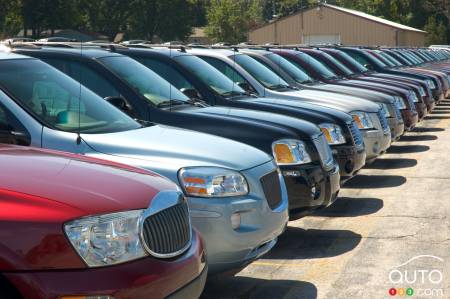Set your limits
There is one basic rule that applies when calculating the maximum amount that you can invest in the monthly payments for a new vehicle, whether you buy or lease. Most financing experts recommend that your car payment should not exceed 20 percent of your combined living expenses such as the monthly rent (or mortgage), energy costs, utilities like phone and cable, food, credit cards and other recurring expenses. But be careful: the more you have bills, the less money there is for your car payments.
Interest Rates : A Deciding Factor
Regardless if you choose to buy or lease, remember this: a short-term contract means a lower interest rate than with a long-term contract. For example, a manufacturer might offer a 4.59-percent rate for a 36-month lease, a 5.99-percent rate for a 39-month lease or a 6.59-percent rate for a 48-month lease. In addition, if your creditor considers you as a risky borrower, chances are your interest rate will be higher than if you were known to be solvent.
Longer Amortization Periods
Over the past few years, dealers and financial institutions have started offering vehicle financing for increasingly longer periods. Whereas banks used to loan money for 3-4 years two decades ago, they're now happy to offer 5-, 6- or even 7-year terms. Why? Because vehicle prices keep rising - as do their durability and reliability.
Buying or Leasing?
For various reasons, a growing number of consumers now prefer leasing a vehicle instead of buying it. What's the difference? When you buy, the financing applies to the total cost of the vehicle, including taxes, and the interest rate is determined by your bank or some other financial institution. You then repay your loan with monthly payments over a given number of years. On the other hand, when you lease a vehicle, the financing applies to the use of the vehicle. You only pay for a certain part of the car, based on how much you will be using it over the length of your leasing contract. To fully understand the obligations of both the dealer and the consumer in the case of a purchase or lease, Quebec's l’Office de la protection du consommateur du Québec offers lots of information in the form of various publications and specialists.
Benefits of a leasing contract:
| Benefits of a sales contract with financing:
|
Is buying costlier than leasing?
In general, a lease will prove costlier than a purchase. Sure, your monthly payments are lower, but you're paying on a permanent basis.
Once the leasing contract comes to an end, you have to find a new car… unless you decide to buy it back. This solution sometimes offers sizeable benefits (see the section dedicated to residual values). If you choose to lease a different vehicle, you will have to sign another contract with different monthly payments.
If you bought your vehicle and decide to keep it for four additional years once the final payment is completed, you will only have to pay for ownership and maintenance costs.
Residual Values
The residual value is extremely important when it comes to leasing a vehicle. For instance, if you plan on handing back the vehicle at the end of your contract and leasing a new one, it's in your best interest to choose a model with a high residual value (around 50 percent of its initial value).
On the other hand, a residual value that's lower than the actual market value could lead you to buy the vehicle back at the end of the lease term and either keep it or sell it to a private individual.
Remember that the residual value is determined by actuaries who analyze market trends. The consumer always remains dependent on this analysis.
The following table will give you an idea of monthly payments for a $30,000 vehicle (before taxes) with a 48-month financing at 6 %; the residual value is taken into account.
Monthly payments affected by residual value
- 48-month lease of a $30,000 vehicle -
| Initial price of vehicle ($) | 30,000 | 30,000 | 30,000 | 30,000 | 30,000 | 30,000 |
| Residual value (%) | 35 | 39 | 42 | 45 | 48 | 52 |
| Residual value ($) | 10,500 | 11,700 | 12,600 | 13,500 | 14,400 | 15,600 |
| Amount to finance, without taxes ($) | 19,500 | 18,300 | 17,400 | 16,500 | 15,600 | 14,400 |
| Amount to finance, with taxes ($) | 22,220.25 | 20,852.85 | 19,827.30 | 18,801.75 | 17,776.20 | 16,408.80 |
| Term (months) | 48 | 48 | 48 | 48 | 48 | 48 |
| Monthly payment with taxes ($) | 521.84 | 489.73 | 465.64 | 441.56 | 417.47 | 385.36 |
| Interest paid ($) | 2,828.22 | 2,654.18 | 2,523.65 | 2,393.11 | 2,262.58 | 2,088.53 |
As you can see, the monthly difference between a vehicle with a residual value at 52 percent and another with a residual value at 35 percent is $136.48. For some, this represents a significant amount of money.
A residual value at 35 percent means you should definitely consider buying the vehicle back at the end of your lease term. On the other hand, at 52 percent, your best option is to lease another vehicle.
Incidentally, new vehicles usually arrive on the market with a fairly high residual value. However, after just a couple of months, this value is progressively melting. Better take advantage of it when the vehicle you're looking for is at peak value!
Mileage Limits
Leasing contracts usually come with a mileage limit. Depending on the manufacturer, said limit can go as high as 24,000 km/year or as low as 15,000 km/year. It's up to you to determine whether or not the proposed limit suits your annual driving habits; the exceeding mileage will be charged at the end of your lease term. So, be realistic and avoid bad surprises!






